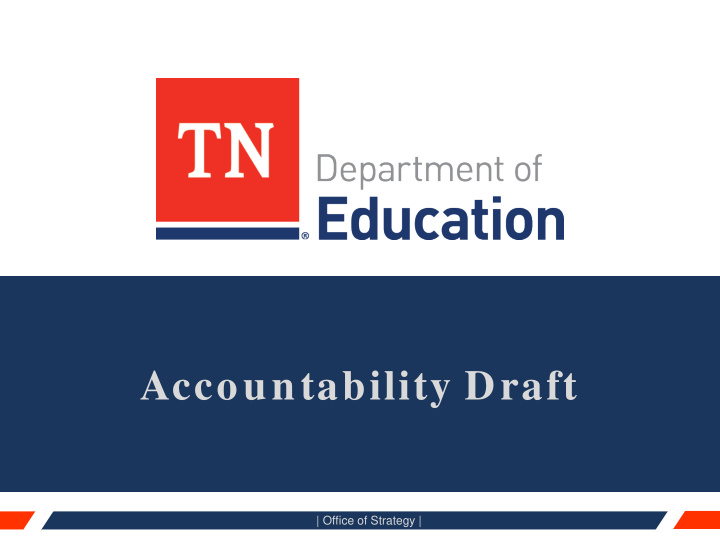



Accountability Draft | Office of Strategy |
Objectives *This slide deck is intended to cover the feedback that we have heard to date (included) at a very high level The Department will discuss major points of feedback received to-date The Department will receive initial guidance from committee members on this work 2
Context: Accountability Letter Grades 2019 2020 School Types School Types • Elementary • K-8 • Middle school • High school • High school • Mixed Grade/K-12 School Scores School Scores Numeric Score A, B, C, D, or F from 0 to 4.0 District Scores District Scores Exemplary • Advancing *No projected change. Satisfactory • Marginal Pending SBE action. In need of improvement With overall numeric score 3 Michael Hardy | Office of Strategy | August 15
FEEDBACK Getting to Letter Grades Intuitive like a report card or a gradebook – Converting parts to a 100-point scale to mirror A-F intuition. Raw Score Scaled Grade Weighted Letter Grade Grade • the score • the raw score • the letter received on a converted to a • the combining equivalent of metric/ 100-pt scale scaled scores scaled or indicator with weights weighted indicating scores priority 4
FEEDBACK Three Spaces: Parts of School Grades School Best of Achievement or Growth Progress or Health Academic Student School Achievement Growth Progress
FEEDBACK Academic Achievement Space The Academic Achievement Score is generally student assessment scores that are on-grade level or above. Any applicable indicators are combined and weighted by number of students served to obtain the Achievement Score. College & Achievement Proficiency Early Grade Career Indicator Indicators Indicators Indicators All schools: 3- High schools Elementary & School Types 8 & Grades & K-12 K-12 schools with EOCs schools 6
School Progress Space: Two Parts Annual Measurable Possible Future Measures Objective (AMO) of School Health Percent of all AMOs Met for – Teacher Retention which the school qualifies – Ready Graduate Access (min. students = 10) – Family Participation Metrics: – Academic Acceleration – Graduation Rates – Student Attendance – TNReady On Track or – Chronic Absenteeism Mastery Rates – Ready Grad Scores – English Language Learner Proficiency Rates – Chronic Absenteeism 7
AMO Success Rate Each year, schools receive Annual Measurable Objectives (AMOs) based on most recent performance. These are REQUIRED. School Progress measures the percent of all AMOs Met for which the school qualifies across the following indicators: – Graduation Rates – TNReady TNReady On Track or Mastery Rates Table & calculation example: – English Language Learner Performance – Chronic Absenteeism Rates 17 AMO targets met 74% 23 AMOs measured – Ready Graduate Rates Black or African English Students w Indicator All Students American White Hispanic Learners Eco. Disadv. disabilities Grad. Rate Met Met Met N/A N/A Met N/A Ready Grad. Met Not Met Met N/A N/A Not Met N/A ELPA Met N/A N/A N/A Met Met N/A Chronic Abs. Met Met Not Met N/A Met Met Met TNReady Met Not Met Met N/A Not Met Met Not Met 8
FEEDBACK Student Growth Space Student Growth can be measured in different ways: Traditional TVAS Individual student growth looks at the % of students who exceeded, met, or fell below their individual projections. Student improvement on proficiency bands to demonstrate those that moved from “Approaching” to “On- Track,” for example. Student group growth highlights groups of students with Individual the most potential to show growth: Student – Lowest quartile of students Growth – Focus student groups 9
Questions Achievement : – Does the State Board have any direction on what must be included in achievement? – Are there any components that you would like to make sure the State addresses? Growth: – Does the State Board have any direction on what must be included in growth? – Are there any components that you would like to make sure the State addresses? Other Measures: – Is there any guidance from the State Board on how you would like the department to think about “Other Measures” 10
District Accountability 11
District Accountability District Accountability should reflect the performance of its schools Calculation options provided through feedback: – District receives rating that corresponds to the average of its schools’ letter grades, weighted by the number of students at each school – District receives the rating of its lowest performing school – Districts receives the rating corresponding to median school STATE BOARD FEEDBACK? 12
Ongoing Feedback The Accountability Survey: The survey is out and will remain open for 3 weeks Superintendent Conference: TDOE has a session with all superintendents focused solely on this topic Group Feedback Meetings: Feedback sessions have been scheduled with a number of stakeholder groups Accountability Email: TDOE is accepting written comment through the accountability email at TNED.Accountability@tn.gov 13
Recommend
More recommend